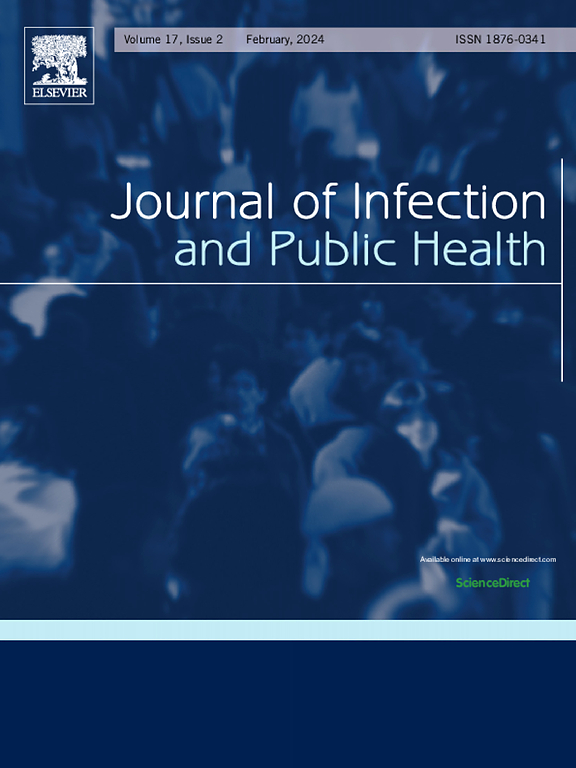东开普省兽医病例中细菌性人畜共患病的趋势和地理分布:十年回顾性分析
IF 4.7
3区 医学
Q1 INFECTIOUS DISEASES
引用次数: 0
摘要
影响牲畜的疾病可对周围生态系统产生连锁反应,特别是通过污染水源。它们的发生造成了重大的公共卫生问题,特别是在易受气候变化影响的地区,以及人与动物经常共用水源的地区,增加了水媒人畜共患病传播的风险。水传播的人畜共患病是由人畜共患病病原体引起的传染病,包括细菌、病毒、原生动物和寄生蠕虫,通过水生环境从动物传播给人类,反之亦然。追踪牲畜中的人畜共患病情况是动物和人类使用的水源可能受到污染的早期指标。本研究分析了十年来水传播细菌性人畜共患病流行趋势,确定了最常记录的人畜共患病及其地理分布,并确定了与这些疾病最常相关的动物物种。细菌性人畜共患病由于其再次出现的可能性、抗菌素耐药性和经济影响,仍然是一个全球性威胁。这项研究采用了南非反刍动物兽医协会(RuVASA)网站上关于牲畜疾病的月度报告。数据按月和重要性等级汇总,以总结重要性等级随时间的变化趋势。在此之后,经常对特定疾病进行研究,每月报告10例以上。本研究的结果显示,在南非东开普省的几个地区,如亚历山大、格拉夫-雷内特和杰弗里斯湾,动物中人畜共患病病例,特别是大肠杆菌病的病例显著增加。与绵羊、牛和山羊相比,牛的所有三种疾病——布鲁氏菌病、大肠杆菌病和沙门氏菌病——患病率最高,强调了它们作为主要宿主的作用。这项研究的发现提供了关键的理解,例如具有最高风险的人畜共患病,疾病传播的当地热点,以及动物的水库,它们在水附近的存在可能会严重污染共用水源。分析可能影响水质并对人畜共患病的传播、传播和暴发构成风险的动物疾病趋势是必要的整体展望,认识到动物卫生的退化可能产生更广泛的环境和公共卫生影响,这符合考虑人类、动物和环境卫生系统之间相互联系的“同一个健康”原则。本文章由计算机程序翻译,如有差异,请以英文原文为准。
Trends and geographic distribution of bacterial zoonoses in veterinary cases in the Eastern Cape: A ten-year retrospective analysis
Diseases affecting livestock can have ripple effects on surrounding ecosystems, especially by contaminating water sources. Their occurrence poses significant public health issues, especially in areas such as the Eastern Cape province in South Africa, susceptible to climatic variations and where people and animals often share water sources, increasing the risk of transmission of waterborne zoonoses. Waterborne zoonoses are infectious diseases caused by zoonotic pathogens, including bacteria, viruses, protozoa, and parasitic helminths transmitted from animals through the aquatic environment to humans and vice versa. Tracking zoonoses in livestock is an early indicator of potential contamination of water sources used by animals and humans. This study analysed trends in prevalence of water-transmissible bacterial zoonoses over ten years, identifying the most frequently recorded zoonoses, their geographical distribution, and determining the animal species most commonly associated with these diseases. Bacterial zoonoses remain a global threat due to their potential for re-emergence, antimicrobial resistance, and economic impact. This study employed monthly reports on livestock disease from the Ruminant Veterinary Association of South Africa (RuVASA) website. The data was aggregated by month and scale of importance to summarise the trend in scale of importance over time. Following this, the specific diseases frequently, with more than 10 cases reported monthly, were explored. The findings from this study reveal a notable rise in cases of zoonoses in animals, particularly colibacillosis, across several regions in Eastern Cape, South Africa, such as Alexandria, Graaff-Reinet, and Jeffreys Bay. Cattle had the highest prevalence of all three diseases—brucellosis, colibacillosis, and salmonellosis—emphasising their role as key reservoirs, compared to sheep, cattle and goats. The findings of this study provide critical understanding, such as zoonoses posing the highest risk, local hotspots for disease transmission, and the animal's reservoirs that will potentially and significantly contaminate shared water sources by their presence near water. Analysing trends in animal diseases that can impact water quality and pose risks for zoonosis transmission, spread and outbreak is the needed holistic outlook recognising that regress in animal health can have broader environmental and public health implications, which is in line with the One Health principle that considers the interconnectedness between human, animal, and environmental health systems.
求助全文
通过发布文献求助,成功后即可免费获取论文全文。
去求助
来源期刊

Journal of Infection and Public Health
PUBLIC, ENVIRONMENTAL & OCCUPATIONAL HEALTH -INFECTIOUS DISEASES
CiteScore
13.10
自引率
1.50%
发文量
203
审稿时长
96 days
期刊介绍:
The Journal of Infection and Public Health, first official journal of the Saudi Arabian Ministry of National Guard Health Affairs, King Saud Bin Abdulaziz University for Health Sciences and the Saudi Association for Public Health, aims to be the foremost scientific, peer-reviewed journal encompassing infection prevention and control, microbiology, infectious diseases, public health and the application of healthcare epidemiology to the evaluation of health outcomes. The point of view of the journal is that infection and public health are closely intertwined and that advances in one area will have positive consequences on the other.
The journal will be useful to all health professionals who are partners in the management of patients with communicable diseases, keeping them up to date. The journal is proud to have an international and diverse editorial board that will assist and facilitate the publication of articles that reflect a global view on infection control and public health, as well as emphasizing our focus on supporting the needs of public health practitioners.
It is our aim to improve healthcare by reducing risk of infection and related adverse outcomes by critical review, selection, and dissemination of new and relevant information in the field of infection control, public health and infectious diseases in all healthcare settings and the community.
 求助内容:
求助内容: 应助结果提醒方式:
应助结果提醒方式:


